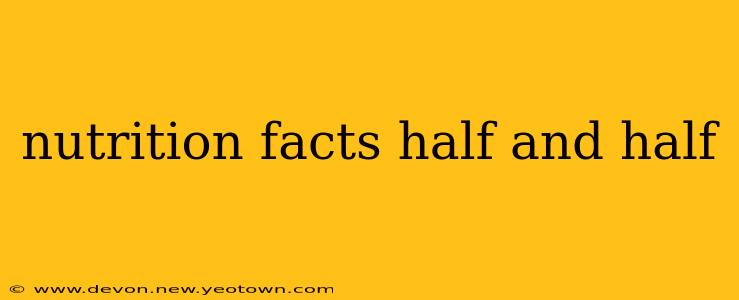Half-and-half. That creamy, dreamy dairy blend that elevates coffee, soups, and countless other dishes. But have you ever stopped to consider what's actually in that carton? Beyond the deliciousness, understanding the nutrition facts of half-and-half is key to making informed choices about your diet. This isn't just about calories; it's about understanding the macronutrients, the potential health impacts, and how it fits into your overall eating plan. Let's unravel the mysteries of this kitchen staple.
What are the main nutritional components of half-and-half?
Half-and-half is essentially a mixture of milk and cream, typically containing around 10-12% milkfat. This fat content significantly impacts its nutritional profile. The primary components are:
- Fat: This is where the majority of the calories come from. It contributes to the rich, creamy texture we love, but also packs a calorie punch. The type of fat is primarily saturated, something to consider as part of a balanced diet.
- Protein: Half-and-half provides a modest amount of protein, contributing to satiety and overall nutrient intake.
- Carbohydrates: The carbohydrate content is relatively low, mainly coming from lactose, the natural sugar in milk.
- Vitamins and Minerals: While not a powerhouse of nutrients, half-and-half does contribute small amounts of calcium, vitamin A, and riboflavin.
The exact nutritional breakdown varies depending on the brand and specific product. Always check the nutrition label on the carton for the most accurate information.
How many calories are in half-and-half?
This is a question many people ask, and the answer, as with most things nutritional, is "it depends". A typical serving size (about ¼ cup or 60ml) of half-and-half can contain anywhere from 50-70 calories. The calorie count increases proportionally with the amount consumed. This seemingly small amount adds up quickly, especially if you’re using it liberally in your coffee or cooking.
Is half-and-half high in saturated fat?
Yes, half-and-half is relatively high in saturated fat compared to other milk products like skim milk. Saturated fat intake should be moderated as part of a healthy diet. While not inherently "bad," excessive consumption of saturated fat is linked to potential increases in LDL ("bad") cholesterol levels. However, it's important to remember that saturated fat is not the enemy; it's about moderation and balance within a broader dietary context.
How does half-and-half compare nutritionally to other milk products?
Here's a quick comparison to help illustrate the differences:
| Product | Fat Content (%) | Calories (per ¼ cup) | Saturated Fat (per ¼ cup) |
|---|---|---|---|
| Skim Milk | <1 | ~20 | ~0 |
| 1% Milk | 1 | ~30 | ~1 |
| 2% Milk | 2 | ~40 | ~1.5 |
| Whole Milk | 3.25 | ~50 | ~2 |
| Half-and-Half | 10-12 | ~50-70 | ~4-6 |
| Heavy Cream | 36+ | ~100+ | ~8+ |
This table shows that half-and-half sits firmly in the middle ground between whole milk and heavy cream concerning fat content. The nutritional profile changes drastically as the fat percentage increases.
What are some healthier alternatives to half-and-half?
If you're looking to reduce calories and saturated fat, several healthier alternatives can provide a similar creamy texture:
- Reduced-fat milk: Offers a lighter consistency while still providing calcium and other nutrients.
- Milk alternatives (plant-based): Soy, almond, oat, and other plant-based milks offer a lower-calorie, often lower-fat, and dairy-free option. However, these vary widely in nutritional content, so check labels carefully.
- Unsweetened almond milk + a touch of vanilla extract: This can create a surprisingly creamy and flavorful addition to coffee.
Ultimately, the “best” choice depends on your individual dietary needs and preferences. The key is informed decision-making based on understanding the nutritional information.
By understanding the nutrition facts of half-and-half, you can make conscious choices about its inclusion in your diet. Remember, moderation is key, and awareness is power. Enjoy that creamy goodness responsibly!

